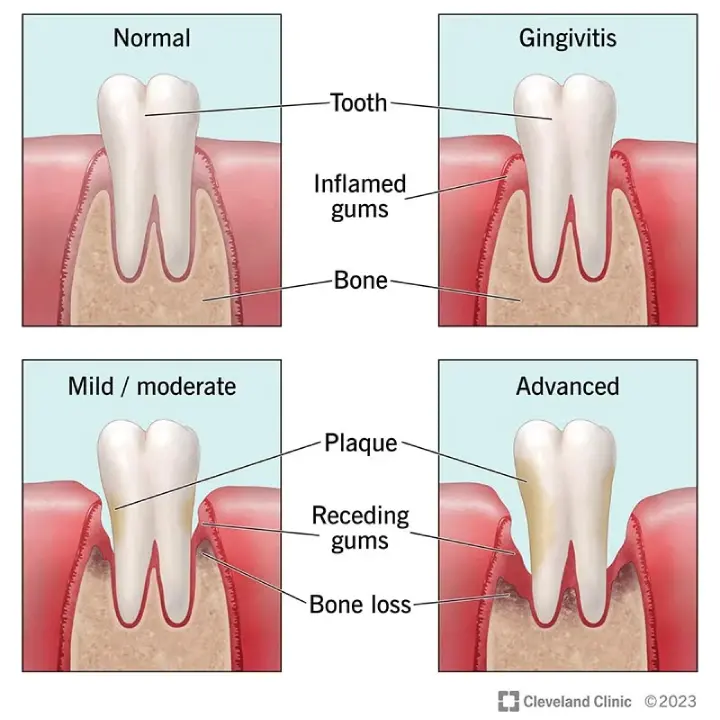
LANAP procedure for gum disease starting at $595
Specialized dental care for periodontal disease
If you’re experiencing any periodontal disease symptoms, Dental Corner is here for you. Book an appointment with your local periodontist today.
Periodontal disease (periodontitis) treatment options
Treat for early-stage gum disease (gingivitis) treatment options
Your Dental Corner dentist will work with you to determine the best care plan for you and your smile. Discover possible periodontal disease treatment options below.
Dental cleaning and improved oral hygiene. Gingivitis is the earliest stage of gum disease. It’s relatively easy to treat and can usually be controlled with a cleaning from your Dental Corner care team.
Treatment for periodontitis
Your Dental Corner dentist will work with you to determine the best care plan for you and your smile. Discover possible periodontal disease treatment options below.
If things progress beyond gingivitis, it can affect the bone supporting your teeth, also known as periodontitis. The first step to periodontal disease treatment usually involves scaling and root planing. This treatment may be done over more than one visit, depending on your personal needs.
Scaling: First, your dentist or hygienist removes plaque and tartar with specialized instruments below the gum line and disinfects the area using medication.
Root planing: Then, the root surfaces of your teeth are smoothed, or “planed”, to promote the gum tissue to heal and reattach to the roots of your teeth. To enhance healing and minimize any discomfort, it’s possible that your dentist may recommend a prescription for you.
Treatment for advanced periodontitis

Your Dental Corner dentist will work with you to determine the best care plan for you and your smile. Discover possible periodontal disease treatment options below.
Sometimes, scaling and root planing isn’t enough to completely treat the gum disease. If your periodontal pockets don’t fully heal after scaling and root planing, periodontal surgery may be the best next step.
Surgery can help remove plaque and tartar from hard-to-reach areas. Your dentist will advise you of the stage of gum disease and potential outcomes during consult.
Pocket reduction surgery
People with moderate to advanced gum disease may need pocket reduction surgery (also called osseous surgery). The goal is to remove plaque and tartar that are so deep under the gums that your hygienist can’t reach it. During this procedure, a periodontist makes an incision (cut) in your gums and creates a flap. This allows them to temporarily move your gums back from your teeth roots.
Next, they’ll clean the plaque, tartar and bacteria from your teeth roots and smooth out any rough areas. Once complete, they’ll reposition your gums and close the incision with stitches.
Oftentimes, periodontists combine pocket reduction surgery with other regenerative procedures, such as bone grafting, gum grafting or guided tissue regeneration.
Bone grafting
Your periodontist may use a dental bone graft to replace bone that you’ve lost to gum disease. Once they clean the infection out, they’ll place bone grafting material into the areas where the bone has eroded. This material acts as scaffolding or a space-holder, giving your body time to regenerate its own bone over time.
Gum grafting
If you’ve lost gum tissue to periodontal disease, your dentist may recommend gum graft surgery, also called tissue grafting. This procedure covers exposed teeth roots and adds thickness to your gum line.
During this procedure, a periodontist will add tissue to the areas of gum recession. This tissue may come from the roof of your mouth, or your provider may purchase it from a licensed bone and tissue bank.
LANAP Surgery FAQs
What to expect during the LANAP treatment
LANAP periodontal surgery is a full-mouth procedure usually completed in two, 2-hour visits. Splinting of loose teeth may occur during this visit if necessary. One side of the mouth is completed during the first visit, and a week later the other side is then completed at the second visit. It is very common for patients to quickly resume normal activities or return to work.
What should I expect the first few days after LANAP treatment?
LANAP is a surgical procedure, so your body will adjust depending upon your individual pain tolerance. The first few days following the surgery you may experience mild soreness of the treated areas- generally alleviated with Ibuprofen. The gum tissues around the teeth may appear slightly discolored. Splints may be fabricated to stabilize and immobilize the teeth. It is important that you wear these splints as instructed to promote healing. Expect to have your bite adjusted during visits several times over the coming months; this is very important for healing.
- Do not brush or floss for the first 7-10 days after treatment.
- Follow a soft diet as recommended by your treating dentist.
- Do not smoke. Smoking interferes with the healing process by impairing the body’s defense mechanisms.
What is the cost of LANAP treatment?
Laser-assisted periodontitis treatment may sound expensive, but it doesn’t have to be. The average cost of LANAP treatment in the US is between $2,000-$8,000 depending on how many areas you need the treatment on. At Dental Corner LANAP is only $595 – $1,231.
Is LANAP surgery worth it?
Studies have shown that the procedure can lead to a significant reduction in pocket depth and an increase in attachment level. Additionally, LANAP has been shown to improve gum health and reduce bleeding and inflammation. If you’re worried about loose teeth, LANAP can also help where conventional treatment might fail.
Is LANAP surgery painful?
The LANAP protocol usually doesn’t even require pain medication following the procedure, causing very little discomfort. The recovery time following a LANAP procedure is also very brief, and patients can usually resume all normal activities within just a few days.
Who is a candidate for LANAP?
A better question is who is not a candidate for this procedure. Patients who would not benefit from this procedure would be patients with healthy gums or who only have gingivitis. If your gum pockets are less than 5mm, you are a not a candidate.
What is the success rate of LANAP?
How Effective is LANAP? Scientific studies have shown positive results for the effectiveness of LANAP in the treatment of periodontal disease. The following has been shown: LANAP to have a success rate of 87.9%
Is LANAP better than scaling and root planing?
LANAP: Many patients prefer LANAP for its comfort, shorter treatment times, and quicker recovery. RSP: Some patients may find RSP more uncomfortable due to the scraping and scaling involved.
What are the benefits of LANAP?
- Less pain
- Less bleeding
- Less sensitivity
- Less gum loss
- Less swelling
- Very little downtime after treatment
- Less Post-op infections
- Promotes regeneration of supporting gum tissues
- Healing is perceived to be faster and more comfortable than conventional surgery
What are the pros and cons of LANAP?
The Pros of LANAP
Effective in Treating Gum Disease. One of the main benefits of LANAP is its effectiveness in treating gum disease. The procedure’s laser technology focuses on and eliminates infected gum tissue, preserving healthy tissue in the process. This helps to reduce the risk of future gum disease and promotes the regeneration of healthy gum tissue. In addition, LANAP has received FDA clearance for the true regeneration of deteriorated bone, making it a viable option for those experiencing bone loss due to gum disease.
Less Invasive Than Traditional Gum Surgery. Compared to traditional surgical procedures like bone grafting or flap surgery, LANAP is a less invasive form of treatment. The laser technology used in the procedure eliminates the need for incisions and sutures, which can lead to a more comfortable healing process and a reduced risk of infection.
Faster Healing Time. One of the main advantages of LANAP over traditional gum surgery is its shorter recovery time. Patients who undergo LANAP can often return to their regular activities within 24 hours, whereas recovery from traditional surgery can take several days or even weeks. This is due to the minimally invasive nature of the laser treatment, which causes less trauma to the gum tissue and promotes faster healing.
Minimal Postoperative Discomfort. Patients who have undergone LANAP report minimal pain and discomfort during the healing process. The laser technology used in the procedure causes less bleeding and swelling compared to traditional surgical procedures, which can lead to a more comfortable recovery period. In addition, the need for prescribed pain medications and post-operative swelling management is typically reduced with LANAP treatment.
The Cons of LANAP:
Not Covered by All Dental Insurance. One potential drawback of LANAP treatment is that it may not be covered by all dental insurance providers. This can make the procedure more expensive for some patients, especially if they need to pay for the treatment out of pocket. It is essential to check with your health insurance provider to determine if LANAP is covered under your plan and what your out-of-pocket expenses may be.
May Be More Expensive Than Traditional Gum Surgery. In some cases, LANAP may be more expensive than traditional gum surgery. The procedure’s cost can vary based on factors like the scope of the treatment needed, the severity of your gum disease, and the dental practice’s location. However, it is also important to consider the number of benefits LANAP provides when weighing the costs.
Not Suitable for All Cases of Gum Disease. While LANAP is an effective treatment option for many patients with gum disease, it may not be suitable for all cases. Patients with extremely advanced gum disease or other complicating factors may require more invasive surgical procedures to adequately treat their condition. It is essential to consult with a licensed periodontist to determine if LANAP is the right treatment option for your specific case of gum disease.
Limited Availability in Some Areas. Finally, LANAP treatment may not be available in all areas, as dentists must undergo comprehensive training at the Institute for Advanced Laser Dentistry to be certified to perform the procedure. This can make it more challenging for patients in some regions to access LANAP treatment. However, the growing popularity of the procedure means that more dental professionals are becoming certified to perform LANAP, increasing the availability of this innovative treatment option.
Medical references and resources
Periodontal (Gum) Disease | National Institute of Dental and Craniofacial Research
– https://www.nidcr.nih.gov/health-info/gum-disease
Periodontitis – Symptoms and causes – Mayo Clinic – https://www.mayoclinic.org/diseases-conditions/periodontitis/symptoms-causes/syc-20354473
Periodontal Disease | Oral Health Conditions | Division of Oral Health | CDC – https://www.cdc.gov/oralhealth/conditions/periodontal-disease.html
Periodontal Disease (Gum Disease): Causes, Symptoms & Treatment – https://my.clevelandclinic.org/health/diseases/21482-gum-periodontal-disease
Gum Disease Information – American Academy of Periodontology – https://www.perio.org/for-patients/gum-disease-information/
Periodontitis: Symptoms, Causes, and Treatments – https://www.healthline.com/health/periodontitis
Periodontal disease – Wikipedia – https://en.wikipedia.org/wiki/Periodontal_disease
Periodontal Disease – StatPearls – NCBI Bookshelf – https://www.ncbi.nlm.nih.gov/books/NBK554590/
Medically reviewed by
#AUTHOR
#DATE
#COPYRIGHT
Caring for you throughout your LANAP treatment
Still have questions about what to expect before, during and after your procedure? We’re here to help—and walk you through it every step of the way.


